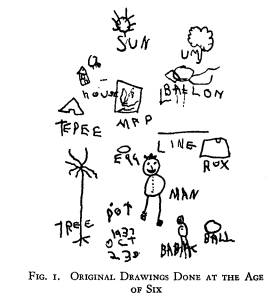
Psychological Clinic, Harvard University
IF a person under deep hypnosis is told that he is six years old, his behavior will be strikingly similar to that of a child of six. This phenomenon has been called hypnotic regression or ablation of personality (16). These terms imply that the individual functions at the suggested age level, that all knowledge acquired after that age is absent, and that the subject's reactions both to familiar and to unfamiliar situations are fully congruent with his behavior potentialities when he was that age.
An alternative explanation is that the subject plays to the best of his ability the role of a child at the suggested age. This hypothesis does not require that all later knowledge be inoperative nor that the subject's duplication of childhood behavior be wholly successful; his behavior will be merely an approximation of what might have occurred at the suggested age. It is these two hypotheses -- regression or ablation on the one hand, role playing on the other -- that we shall attempt to evaluate.
Under the hypnotic suggestion of an early age the Ss in our experiments were confronted with an entirely new situation represented by the Rorschach test.2 The nature of this test is such that it is almost impossible to attempt a conscious approximation of a child's performance. Further, in order to test the S’s reactions to familiar situations, drawing and handwriting samples were taken under hypnosis. Later, in the waking state, the Ss themselves were used as controls. These control tests were taken two to five days after the hypnotic interview.
EXPERIMENTAL PROCEDURE
The experimental conditions were made constant as far as possible. All experiments were conducted at the Harvard Psychological Clinic. Individuals chosen as Ss were Harvard University students between between 17 and 26 years of age. Only Ss who showed a genuine somnambulistic state in hypnosis were used, and extreme care was taken in establishing beyond any doubt the somnambulistic condition of each S in every single hypnotic session by the use of all accepted criteria for this state. After this condition had been established and repeatedly tested, the suggestion was given that S was six years old. He was then encouraged to describe his surroundings, including persons around him. Only when this description was very vivid and included material not specifically suggested, was the experiment continued. In order to produce standard conditions it was suggested to each S that he was attending his sixth birthday party.
Then, before the Rorschach test was given, it was suggested that it was the day after the birthday and S was attending school. This environment appears to be consistent with a test situation and is not emotionally charged in such a way as to introduce extraneous elements into the test results. After the Rorschach test had been given, S was asked to draw a man, a house, and a boat, to write his name, and to write a short passage from dictation. After completion of these tests post-hypnotic amnesia was suggested and S was awakened. Two to five days later the same tests in the same order were given to the Ss while awake. He was then asked to repeat the drawings and a handwriting sample according to his own conception of how he would have drawn at the age of six.
RESULTS
Drawings and Handwriting Samples
Original drawings done at the age of six years by S 6 were made available to E. Figure13 shows these drawings, and Figure 2 the drawings done by S in the somnambulistic state under the suggestion of the age of six. These two sets of drawings show practically no similarity. Five days later, under hypnosis, S was again told to draw these items. The results are shown in Figure 3. Three weeks later the original drawings were shown to
2 One S, Case 10, had previously had three Rorschach tests. He is not included in the tabulation of results.
3 These drawings were sent to the subject in a sealed envelope at the request of E and were given to the latter unopened. The S stated that he had not seen these drawings since they were done.
213
214 Martin T Orne

S for the first time, just prior to hypnosis. While “regressed” he was asked to draw the objects again (Fig. 4). It can be seen that these last drawings closely resemble those done under previous hypnosis but do not approximate the originals, which he had just seen in the waking state.
Because of this unexpected result the experiment was repeated. This time the importance of the originals was emphasized to S in the waking state, and he was asked to examine them in detail. When hypnotized again he drew the pictures shown in Figure 5. Now he drew the man first as a “stickman,” as he had done before, but then spontaneouslv corrected it to approximate the orig-
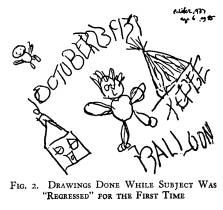
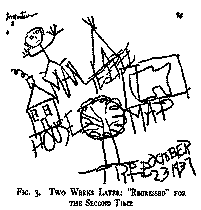
inals more closely. During the same hypnosis he drew pictures shown in Figure 6. Here he structured the man more like the originals but still drew him with hands. Now he was confronted with the originals while under hypnosis and was asked to draw again (Fig. 7). Only under these conditions can a close approximation to the originals be observed. However, even now, many adult features appear clearly in the manner of execution as well as in the concept (see the roots of the tree).
The drawings of all the other eight Ss “hypnotically regressed” showed this main characteristic, namely: While the formal concept was somewhat childlike, the manner of execution was more like that of an adult. This view was corroborated independently by Karen Machover, who was consulted for her expert opinion in reference to the drawings. She stated: “The drawings definitely do not resemble those of six-year-olds. Mature and immature features are intermingled and in certain respects the drawings in regression are
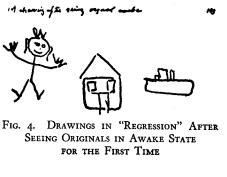
215 Mechanisms of Hypnotic Age Regression
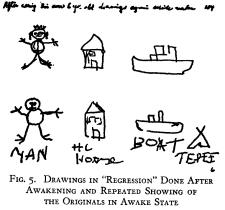
more mature than those done in the waking state. The term ‘sophisticated oversimplification’ seems appropriate for these drawings.” It could be observed that three of our Ss, Numbers 6, 7, and 9, approximated children's drawings more closely when awake than when they were “regressed.” In hypnosis they did not use knowledge pertaining to the actual performance of children, of which they were explicitly aware while awake.
In a number of cases “imagining the age of six,” the drawings are almost identical with those in "regression," as seen in Ss 1, 4, and 5. This may be comparable to the findings in studies concerning relearning after post-hypnotic amnesia has been induced. It has been found that though the subjects were
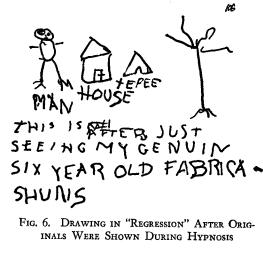
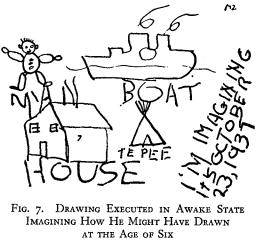
unable to recall having learned the motor skills involved, they learned them considerably faster than a control group (11). In a similar way, our cases in their waking state did not recall having drawn anything in hypnosis. Yet there may be some memory involved of which they were not aware.
An illustration of the peculiar way in which impressions are carried from the hypnotic into the waking state is found in Case 5. His “regressed” Rorschach showed a large number of most unusual locations which even an experienced Rorschach worker would be unable to identify on the basis of the given responses. While testing the limits of the subsequent waking Rorschach test, E remarked that other persons gave quite different responses and asked the subject
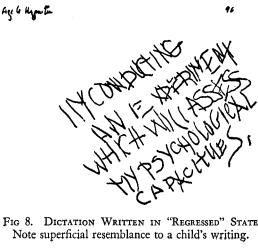
216 Martin T. Orne
whether he would be interested in hearing some of them and in trying to locate them on the plates. He then proceeded to name responses given by the subject in “regression.” These were not recognized by the subject as his own; however, he had no difficulty in pointing out the location of every single one of them. This experiment was carried through three of the Rorschach plates with uniform results.
Expected Changes in Rorschach Criteria under Regression
Though there is considerable divergence among Rorschach workers as to specific norms of children's Rorschach responses at various age levels, there is universal agreement pertaining to certain trends in Rorschach records which correlate with increasing age. Comparing the Rorschach of the same individual at different age levels, we must expect definite differences in formal Rorschach characteristics due to the changes in personality organization during the process of maturation.
The relationship between M and FM is one of the key determinants of emotional maturity. The factor, M, is indicative of inner control and is also an indicator of intellectual capacity. It is farthest removed from conscious influence, as it is exceedingly difficult for the subject to willfully change the number of M responses in his records (14). Accordingly, it would be expected that in “regression” M would decrease in absolute numbers as well as in its relation to FM.
The FC determinant represents the capacity for effective adaptation to the environment. It is a response which shows that the subject is sufficiently mature to incorporate the outside stimulation into an appropriate form. This ability is lacking in a child of six. The type of response to the environment given by the child is that which indicates his inability to control the impact of outside influences. He, therefore, gives the CF or C types of response to color. It follows that the ratio of CF to FC should be larger while the absolute number of FC should be smaller in the “regressed” record.
We know from empirical studies that the child's response to shading is so limited that no norms exist. Therefore, we would expect the amount of shading used to decline considerably in the “regressed” record. All studies show that the number of responses given by a child is considerably smaller than that given by an adult. This is probably due to the child's shorter attention span and generally lower productivity. The m for conflict awareness and C' for general anxiety are, as a rule, absent from a child's record. One of the most generally accepted characteristics of children's records is the fact that A% is considerably higher due to the limited frame of reference which the child has at his disposal. He is forced, as Klopfer puts it, to choose his concepts from the infinite variety of the animal kingdom (13).
Rorschach Test Findings
In a perusal of the protocols themselves there is no difficulty in establishing which are the “regressed” Rorschach records. There are marked childish verbalizations, confabulations, occasional color naming, poor F responses, even poor FM, and, occasionally, poor FC responses. Nevertheless, every single record of “regressed” subjects shows some features which could never be expected in the record of a six-year-old child, and when we consider the formal characteristics alone, it becomes impossible to say which of the Rorschach tests were given in “regression.” As we look at two or three of the psychograms, it seems as if a pattern of change does become evident. However, if we continue to compare all of them, we find opposite trends appearing in others. The writer realizes that one cannot make a Rorschach diagnosis on the basis of a psychogram alone. However, the psychogram portrays those factors which are farthest removed from the conscious control of S and, therefore, are most significant with regard to the question whether or not actual regression takes place.
Table 1 permits a convenient comparison between the “regressed” and the waking tests of each S. It shows that in the hypnotic records there is no consistent shift toward Rorschach scorings indicative of childlike behavior. For example, the number of M shows the expected decrease in the hypnotic state in Cases 4, 5, and 9. This trend, how-
217 Mechanisms of Hypnotic Age Regression
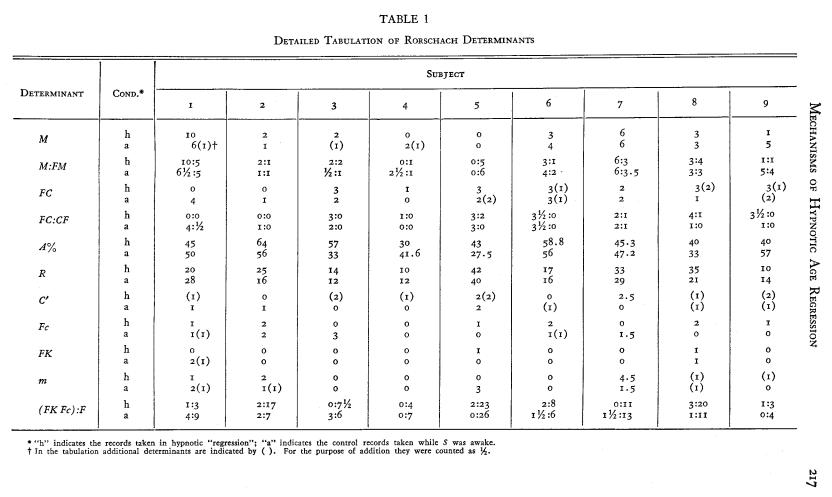
218 Martin T. Orne
ever, is completely reversed in Cases 1 and 2. The A% show marked increase in hypnosis in Cases 2, 3, and 8, but an equally marked decrease in Cases 1, 4, and 9.
Not only is there no consistent trend toward Rorschach criteria typical for children in the hypnotic records when they are compared as a group with those of adult controls, but not one individual hypnotic record shows a shift towards several of the signs with any degree of consistency. Case 3, for example, shows the expected changes by increasing the A% from 33 to 57, and also shows no shading responses in hypnosis, though he gives three Fc while awake. On the other hand, M and FC increase in “regression” from (1) to 2, and from 2 to 3, respectively. Furthermore, he gives two additional C' responses compared to none in the waking stage. A different illustration of the almost ludicrous internal inconsistency of the phenomena is given by Case 9. In his “regressed” Rorschach the number of M fell from 5 to 1, and the number of responses from 14 to 10. Simultaneously, the number of FC, Fc, FC'c, and m, rose from (2) to 3 (1) and from 0 to 1, from (1) to (2), and from 0 to (1), respectively. Furthermore; the A% dropped from 57 to 40. Table 2 presents a summary of the directions of the changes in determinants under the two conditions of administration.
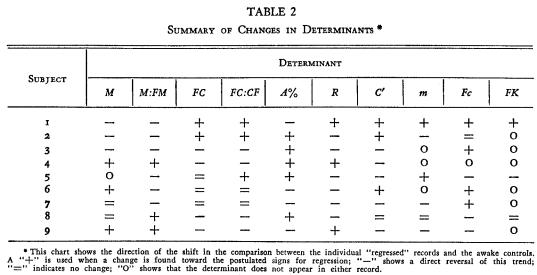
Though there appears to be no consistency of change in the formal Rorschach factors as portrayed in the psychogram, there exists a very uniform change in one formal criterion which is not reflected in the psychogram. The form level (accuracy, specifications, and organization) was in all cases subject to far greater fluctuation in hypnotic “regression” than in the normal state. There was not a great degree of difference in the optimal form level displayed compared to the waking state, but invariably the basal, as well as the average form level, were considerably lower in the hypnotic record. There could be observed a trend toward less specification, occasional inaccuracy, and on the whole a marked decrease in combinatory responses. It is significant that the only Rorschach characteristic which changed consistently was not one reflecting personality organization but, rather, intellectual capacity and critical ability. Furthermore, the form level is the one feature of the Rorschach record which is most subject to conscious control and which tends to be markedly affected by the mood of the moment.
DISCUSSION
Meaning of the Rorschach Results
If the concept of actual age regression is to be accepted, the S in this condition would have to show significant changes in person-
219 Mechanisms of Hypnotic Age Regression
ality organization compared to his waking state. It is unlikely that Rorschach scoring and interpretation in a series of cases would fail to show such a trend if it did exist. Since no such pattern can be found in our series, it seems to be a valid conclusion that the phenomena observed during hypnosis under the suggestion of an early age level cannot be rightfully termed “regression.”
It is, however, equally apparent that deep personality changes do take place which are reflected in the Rorschach pattern. It seems that different changes occur in different individuals, the hypnotic situation having, perhaps, varied subjective implications. Whereas in order to view the problem of “regression” in its true perspective, it was necessary to take records of a comparatively large number of Ss, it would be necessary to make a longitudinal study of the single cases in order to determine the dynamic forces causing the different reactions of each individual to the same situation. Such a study lies outside the scope of this paper. All that is possible for us to establish is the fact that several modes of adaptation to the suggested “regression” occur, and that the types of reaction are by no means uniform. The personality organization seems to change, but at all times we are dealing with the personality organization of the adult.
Inconsistencies in the Clinical Picture
Before attempting to explain the irregularities in the Rorschach picture, we must consider the corresponding irregularities in the clinical picture of the experimental situation. Several of our cases can serve as an illustration. Subject 7 was regressed to the age of six, at which time he had been unable either to speak or to understand English. In the regressed condition, however, he exhibited no difficulty in understanding English addressed to him by E. When asked what time it was, he looked at his wristwatch, which he surely did not wear at the age of six. That the time was actively hallucinated is proven by the fact that he repeatedly gave the time as five o'clock, though the experimenter had covered the face of the watch and the actual time was 12 noon. Subject 6, whose performance has been described in detail before, also gave an illustration of this point. In childlike fashion he wrote without a mistake in spelling: “I am conducting an experiment which will assess my psychological capacities” (Fig. 8). Furthermore, at the accepted age of six years he understood and defined perfectly the word “hypochondriac.” Subject 9 accepted the suggestion to be in school the day after his birthday, which falls on August 7. Subject 5, when asked, “Are you good in arithmetic?” replied, “Yes, better than all the other boys.” Q. “Are you as good as you are now?” A. “No.” Such obvious inconsistencies in the behavior during “regression” occurred in many other instances in our Ss. However, this phenomenon is not new. It is the type of inconsistency which makes even the most ardent proponents of the concept of age regression refer to it as “spotty” and “partial regression.”
This inconsistency of responses seems to have two different implications. It precludes the possibility of the phenomena of age regression being a mere product of the conscious desire to act according to suggestion in hypnosis. No conscious individual could ever overlook such obvious shortcomings, and the realization of the mistake would immediately make him compensate for it. Secondly, it makes it equally obvious that the subject does not function at the suggested age level and that many modes of adaptation learned much later are at his disposal.
Influence of the Hypnotic Situation as Such
When we consider the hypnotic situation of the individual as a whole, these discrepancies appear not to be unexpected. We have suggested to the subject that he is six years old. This he accepts. Further, we have told him that he sees, hears, and feels people who in fact are not present. This he also accepts. The subject's ability to respond to these suggestions, which are at wide variance with reality, indicates in itself that his critical judgment (reality testing) is seriously impaired if not totally suspended. What needs explanation is not that discrepancies exist in this condition, but, rather, that the subject is able to play the suggested part so convincingly.
The marked reduction of critical judgment
220 Martin T. Orne
which takes place in deep hypnosis offers a clue to this phenomenon. It makes it possible for the subject to accept the objectively unreal situation as a reality. The complete exclusion of outside stimuli makes it easier for the subject to maintain this feeling of reality. All available memories of the suggested age are organized into this imaginary world -- in our experiment, the world of a six-year-old. Thus we may reformulate the concept of age regression by saying that the prevailing psychological condition enables the individual to take the role appropriate to the imagined world.
Since we have given only the suggestion of a certain age, without any further clue to the expected behavior, the only point of reference as to the type of behavior to be exhibited lies in the memory of the subject. This fact introduces certain characteristic flaws, which appear with considerable consistency.
It has been observed in previous investigations that the psychological performance of the hypnotized subject in age regression appears as a whole on a higher level than that of the suggested age. Sylvia Brecher (5) states that all motor coordination tests show a higher age level than that to which the subject was regressed. A similar deviation from the suggested age level was noted by her in the Rorschach tests. Bergman (3) points out that in his tests of regressed subjects all drawings were somewhat more advanced than could be expected. H. Spiegel's experimental data show the same phenomenon (16).
It can be assumed that for the formation of a vivid picture of the suggested age, memories are being used, a good part of which actually stem from different times and are erroneously projected into this period of life. These memories are mostly from a later life period, since the more recent memories are more abundant and more easily available. At the same time these contaminate those which actually belong to the suggested age, thus making the responses of the regressed individual appear to be of a later age level.
Reasons for Improved Role-Taking Ability
We have tried to account for the remarkable discrepancies found in the state of hypnotic age regression. However, it was demonstrated by the Rorschach test, as well as by the clinical picture, that the ability to take the role of a child is improved by hypnosis. Several factors combine to produce this effect. Hull states that “there is some striking experimental evidence which, while not absolutely convincing, tends strongly to confirm the clinical observations that hypnosis facilitates the recall of childhood . . . memories” (11, p. 127). This additional capacity to remember enables the subject to form a better picture of how he may have reacted when he was a child. The lowering of the critical judgment permits him to fill in missing parts of this picture with appropriate confabulations and with available memories from his later or earlier life.
The entire situation is then vividly imagined and finally actively hallucinated. These hallucinations are of a dynamic nature and elicit appropriate behavioristic and emotional reactions. Due to the single-mindedness of the hypnotized S and the thorough preoccupation with the situation, made possible by the virtual exclusion of outside stimuli, S is now able to respond with purposeful behavior more appropriate to the suggested age level than would be possible in the waking state. When we try to take the role of a child while we are awake, we do not encounter such conditions. In certain aspects of behavior, particularly in intellectual function, we may be able to do even better in approximating the child's behavior than we can in hypnosis. However, we will never be able to act as convincingly in our total behavior. Since we retain our critical judgment, the situation strikes us as somewhat ludicrous and arouses feelings of self-consciousness. Even if these are overcome, we are always aware of playing a part, while the hypnotized person accepts his part as reality. Thus the convincing impression given by the hypnotized person appears to be caused, not so much by a greater capacity to play the part during hypnosis, but more by the inability, in the normal state, to assume a role fully on an emotional level.
Confabulation as a Deceptive Feature of Hypnotically Regressed Behavior
The increase in the ability of role taking cannot fully explain the fact that even ex-
221 Mechanisms of Hypnotic Age Regression
perienced investigators have become convinced of the validity of true age regression. A factor which so far has not been considered was brought out clearly by the Stalnaker-Riddle poetry experiments on long-forgotten memories (18). It was found in these experiments that an S, when asked to quote poetry which he had learned long ago, did considerably better in hypnosis than in the waking state. However, a substantial percentage of this improved performance was apparent rather than real. The hypnotized S would make up appropriate filling pieces for such parts of the poetry as he could not remember.
Confabulations of this kind can easily be checked in known poetical pieces. It is, on the other hand, impossible to verify descriptions of school rooms or detailed descriptions of friends and relatives given in the state of “regression” to the age of six years, which means a period of 15 to 20 years ago. It may well be assumed that a great deal of this hallucinated environment also consists of confabulations. These hallucinations, however, become extremely deceiving, as they represent a subjectively real situation, and, therefore, are produced with complete sincerity.
This viewpoint is supported by several bits of information which were accessible for verification. Three of our Ss hallucinated dates, in one case in particular, in a quite spontaneous fashion. When it was suggested that S4 was attending school on the day after his birthday, he replied, “No.” When asked to explain why he was not in school, he answered: “There is no school, it is Saturday.” He had given the date of his birthday as March 8, which in the year in question was actually a Sunday. The date in the current year was a Monday. This same fallacious statement was produced in a later hypnosis, a fact that would have lent credibility if it had not been possible to check it.
A different instance of confabulations of this sort appears in Case 8, who first was unable to recall the name of his first-grade teacher while “regressed” to six years. When a visual hallucination of the teacher was induced, he described her in detail. Suddenly he seemed to recognize her and named her “Miss Curtis.” He was emphatic and positive in this recognition. In the subsequent waking state, with post-hypnotic amnesia, he was asked who “Miss Curtis” was, and he immediately identified her as his teacher of the seventh or eighth grade “near the end of my grammar school.” He was sure that she was not his teacher in the first grade and he could not remember the name of any other grammar school teacher.
In hypnosis the S was apparently unable to recall the real name of his first-grade teacher. Under psychological pressure, when the only available name of a grade school teacher presented itself, it was organized into the situation. It can be assumed that at that time the subject believed he was giving the correct name, thus making the statement in a thoroughly convincing manner, so much so that it was very surprising for the investigator when the statement turned out to be incorrect.
Case 10 presented us with an opportunity to use for our study his Rorschach taken at the actual age of six. The experimenter thought it would be interesting to suggest during the first hypnosis the situation of this original taking of the Rorschach test. The subject hallucinated the situation very vividly. The experimenter then suggested that the subject was holding Card 1 in his hands, told him to open his eyes and to “tell me whatever you see on this card and what it means to you.” In this experiment no real card was used. The subject gave a response to the hallucinated card, in fact he gave the popular response to Card 1. The same procedure was followed with all ten cards. In reference to various cards, the subject was asked whether or not they were colored. He was unable to attribute color to the proper cards. However, he maintained with considerable tenacity that certain cards were colored which are actually achromatic, and vice versa. On the other hand, he attributed the M response popular for Card 3 --“two people bowing like butlers”-- to the hallucinated Card 7, and maintained that this card was achromatic. The subject had previously been used in a longitudinal study and had been given three Rorschach tests in the years 1935, 1937, and 1942.4 Though he had given a large number
222 Martin T. Orne
of responses both in 1935 and in 1937, no M was among these. In 1942, at the age of 13, he had given the usual M for Card 3. It is evident that the hallucinated situation was in no way identical with the actual situation at the age of six. The single response, which was just pointed out, illustrates the entire psychological process which took place: The response, which was remembered and was given, had been taken from memories of a far later stage of development, namely, the age of 13, and was fitted into the suggested situation at the age of six. Furthermore, being unable to recall the correct sequence of the cards, the S confabulated a convenient sequence to which he then clung in a consistent fashion.
It was, of course, never expected that the subject would give a duplication of his Rorschach at the age of six. Nevertheless, it seemed reasonable to expect that the type of responses, if any at all were given, would either be of an evasive nature or responses of great subjective significance which he had given in one of the previous records, such as “bowing butlers.” The majority of the responses given are actually vague and evasive, such as “leaves, a map, etc.” We find, however, several responses which were apparently clearly seen on the hallucinated card, such as “a house with holes inside,” or “looks like kind of an animal, maybe a frog,” which never appeared in his previous records nor in his later ones. As one would expect, the real Rorschach cards correspond in no way to this hallucinated concept. It is, therefore, reasonable to assume that the S, unable to remember the cards with any degree of accuracy -- he had seen them only three times in his life, the last time six years ago -- confabulated cards with general characteristics of ink blots, to which he then gave responses.
An unusual opportunity to observe the process of confabulation presented itself in Case 7. This S came to this country from Germany in his teens and could not speak English prior to his arrival here. He is now 26 years old. When it was suggested to him that he be at his sixth birthday party, he vividly hallucinated the environment, including the children he was with, etc. It was then suggested: “You see your mother, she is speaking to you.” To the question, “What does she say?” he replied, “Do you like your present?” This statement is obviously not one of historical validity, since at the suggested time the S did not understand English, and it is clear that his mother would not have used this language in addressing him. It is highly probable that the total situation which he described contains many such objective inaccuracies. He described the suggested situation in a childlike fashion and with great vividness; nevertheless, he continued to speak English. This fits with the Rorschach results, which show a tendency toward a childish form level and content but no change in other organization. Thus, the response to the hallucinated situation has an outward appearance strikingly similar to that of a child, but the organization of this response remains at the adult level, as shown in the retention of means of expression learned during adult years. The language element enables us further to observe the dynamic function of the hallucinated environment. After we had established that he could seemingly regress while speaking English, it was suggested that his mother had not used the words, “Do you like your present?” but had said, “Hast du dein Geschenk gern?” It must be noted that no reference was made to the S’s use of English; all that was done was to restructure the hallucinated situation by introducing a change in the direction of objective accuracy. This caused momentary confusion which, however, promptly passed, but from this point on the S ‘s responses were all given in German.
The Dynamics of the Hallucinated Environment
It seems that we are dealing with a dynamic interrelation between the hallucinated reality and the reactions of the S. This hallucinated reality shows many features of objective reality. Among the most outstanding of these is the tendency of the hallucinations to follow a course of their own and to remain constant unless influenced by direct suggestion. On the basis of such features it seems justified to view the relation between the S and his hallucinated environment as a field in dynamic equilibrium. Thus, any
223 Mechanisms of Hypnotic Age Regression
restructuring of this field must lead to changes in the behavior of the S without any direct suggestions of such change.
According to field theory any change within the field will cause a change in all parts of the field. However, the changes made will be the smallest required changes to re-establish the equilibrium of the field. In accordance with this, the introduction of a German-speaking mother in the field forced the S to revert to the use of German. However, he continued to understand the English of the E. The lack of critical judgment in the state of hypnosis prevented him from realizing this paradoxical situation. For the same reason the degree of consistency required in the re-establishment of the field is far lower in hypnosis than in the waking state. The question, “Do you understand English when your parents speak it?” was repeatedly reformulated in English (ten times), each time evoking a negative answer. This inconsistency was not sufficient to disturb the adjustment of the field. It would have been necessary in order to achieve consistency to restructure the field in such a way as to lose contact with the E, but this would have been incompatible with the hypnotic situation. When the S was asked to speak English because a friend who was introduced to him could not understand German, he very gradually reorganized again and spoke English. This promptly brought about such severe changes in the field that he lost contact with the hallucinated situation completely, and when asked, “Where did you learn English?” he replied in a hesitant fashion, “Here . . . America.” When he was again told that he was six years old and in Berlin, he promptly lost his ability to speak English. It seems that the field as a six-year-old had been stably restructured by making his mother speak German, and no amount of psychological pressure could make him speak English while the field remained intact.
Another example of the dynamic equilibrium of the field and its capacity to maintain its integrity with as few changes as possible is presented in Case 6. The drawings of this subject made “in regression” were widely different from the originals made at the age of six. When these originals were shown to the S while awake, it was expected that a radical change would occur when the drawings were repeated in hypnosis. These changes, however, were insignificant, and the drawings resembled the prior drawings in hypnosis much more closely than the originals which the S had just seen. The point of reference given to the S in his waking state just prior to hypnosis had practically no influence on the new hypnotic drawings. This seems to be proof that we are not merely dealing with intellectual role taking but, rather, with a response to an hallucinated field. This field reappears with considerable stability in subsequent hypnoses so that his knowledge in the waking state of how he had actually drawn at the age of six had very little influence on the S in hypnosis. The only real approximation occurred after the originals were shown during hypnosis, and the S was told that he had done them. Only then were his drawings organized into the hallucinated field as his own.
The same case may serve as an illustration of the fact that any change in the field causes changes in the entire field. This S had spelled the sentence, “I am conducting an experiment, etc.,” without an error, using a childlike manner of handwriting. In a later hypnosis the suggestion was given, “A child of six does not draw that well,” no reference being made to the spelling. This caused only a very slight change in the drawings, but the S lost completely his capacity for spelling. When he was put under psychological pressure to try to spell “psychological,” he was distressed to the verge of tears but could not fulfill the command. It seems that the field had undergone thorough reorganization when the additional clue to the behavior of a child had been given. Once it was established on its new basis, changes in the field again became difficult.
From the preceding discussion it becomes evident that the phenomenon of hypnotic age regression is not one of re-enacting an earlier phase of developmental history, but that it can be viewed in terms of role taking on an emotional basis. Random memories from a long period of life are combined and further supplemented by appropriate confabulations. Thus, an hallucinated environment is created
224 Martin T. Orne
of which the S becomes a part. A dynamic equilibrium exists between the S and this environment, making it permissible to refer to it as a field. This field is structured, to the best of the S’s capacity, to resemble that prevailing at the suggested age. Due to the memory processes involved, certain characteristic flaws are introduced. Once the field is established, it has the same subjective validity as would be possessed by an objectively real field. Thus it is able to elicit a series of responses appropriate to the situation which normally could only be given as a reaction to objective reality. This makes both the behavior and the corresponding emotions deceptively approximate the behavior of a child.
SUMMARY AND CONCLUSIONS
Ten university students of ages ranging from 17 to 26 years were used for an experimental evaluation of hypnotic age regression. In the somnambulistic state of hypnosis the age of six was suggested, and Rorschach records and drawing and handwriting samples were taken. As a control, the same procedure was followed with the same Ss in the waking state. Genuine childhood drawings done at the age of six by one S and a Rorschach test given at that age to another S were available and were used for comparative study.
No consistent changes in the Rorschach results obtained during hypnosis could be observed. While the hypnotically regressed Rorschach records were always substantially different from the control normal records, the differences followed no regular or intelligible pattern. Striking inconsistencies in the Ss’ six-year-old behavior gave further proof that important aspects of the adult personality had by no means suffered ablation in consequence of the hypnotically suggested regression.
On the basis of these experiments, conclusions may be summarized as follows: Neither the Rorschach technique nor the drawings and handwriting samples gave evidence of true or complete regression. The personality remains adult under suggestion of the age level of six in hypnosis. The terms “age regression” or “ablation of the personality” appear to be inappropriate. The changes observed in the behavior of the Ss and in the tests used, may be viewed as role taking on a primarily emotional basis. They can be explained in terms of structuring a subjectively real situation and reacting to it in an emotionally and intellectually appropriate fashion. Since this situation is not identical with the situation of the S at the age of six, but is composed of memories ranging over a long period of time supplemented by suitable confabulations, the resemblance to a child's behavior is apparent rather than real. The regressed Ss show many total inconsistencies which they themselves readily recognize when in the normal waking state. It is, therefore, impossible to reconstruct an objectively true life history from data obtained in such a fashion.
The experiments undertaken in this study have no bearing upon the therapeutic efficacy of the hypnotic regression technique. The process of catharsis is aided by the momentary reality of the hypnotically structured situation, and it may well be that a reconstruction of the patient's life history on the basis of hypnotically obtained data has sufficient subjective validity to be a significant aid in the therapy.
REFERENCES
1. BENSLEY, MARY LOU. The use of the Rorschach test with children. (Unpublished paper.)
2. BERGMAN, M. S., GRAHAM, H., AND LEAVITT, H. G. Rorschach exploration of consecutive hypnotic chronological age level regression. Psychosom. Med., 1947, 9, 20-28.
3. BERGMAN, M. S. (Personal communication.)
4 . BOWERS-BUCH, M. K. (Personal communication.)
5. BRECHER, SYLVIA. (Unpublished paper and personal communication.)
6 BRENNAN, M., AND GILL, M. M. Hypnotherapy. New York: Josiah Macy, Jr., Foundation, 1944.
7. BRENNAN, M., AND REICHARD, SUZANNE. Use of the Rorschach test in the prediction of hypnotizability. Bull. Menninger Clin., 1943, 7, 183-187.
8. ERICKSON, M. H. The successful treatment of a case of acute hysterical depression by a return under hypnosis to a critical phase of childhood. Psychoanal. Quart., 1941, 19, 583.
9. FRANK, M. G., AND BOWERS-BUCH, M. K. A study of the plantar response in hypnotic age regression. J. nerv. ment. Dis., 1948, 107, 443-458.
10. HERTZ, MARGUERITE R., AND EBERT, E. H. The mental procedure of six and eight year old children as revealed by the Rorschach inkblot method. Rorschach Res. Exch., 1944, 8, 10-30.
11. HULL, C. L. Hypnosis and suggestibility. New York and London: D. Appleton, 1933.
225 MECHANISMS OF HYPNOTIC AGE REGRESSION
12.MACHOVER, KAREN. (Personal communication.)
13. KLOPFER, B., AND KELLEY, D. The Rorschach technique. Yonkers, N. Y.: World Book Co., 1947.
14. RORSCHACH, H. Psychodiagnostic. Bern, Switzerland: H. Huber, 1942.
15. SIEGEL, M. (Personal communication.)
16. SPIEGEL, H., SHOR, G., AND FISCHMAN, S. An hypnotic ablation technique for the study of personality development. Psychosom. Med., 1945, 7, 272-278.
17. SPIEGEL, H. (Personal communication.) 18. VORHAUS, F. G. Rorschach reactions in early childhood. Rorschach Res. Exch., 1944, 8, 71-91
18. VORHAUS, F. G. Rorschach reactions in early childhood. Rorschach Res. Exch., 1944, 8, 71-91.
19. WHITE, R. W. The abnormal personality. New York: Ronald Press, 1948.
20. WHITE, R. W. Preface to the theory of hypnosis. In S. Tomkins (Ed.), Contemporary psychopathology. Cambridge: Harvard Univ. Press, 1944
21. YOUNG, P. C. The veridicality of hypnotically induced regression. Psychol. Bull., 1937, 34, 784.
22. YOUNG, P. C. Hypnotic regression, fact or artifact. J. abnorm. soc. Psychol., 1940, 36, 273--278.
23. STALNAKER, J. M., AND RIDDLE, E. E. The effect ofhypnosis on long-delayed recall. J. gen. Psychol., 1932, 6, 429-440
Received March 17, 1950.